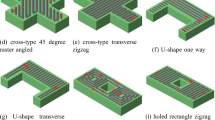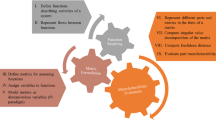Abstract
The underlying complicated spatiotemporal thermo-mechanical processes in additive manufacturing (AM) technology pose challenges in predicting and optimizing the as-built part quality for production use. Physics-based simulations are being developed to provide reliable predictions such as part distortions, residual stresses/strains, microstructure contents, and grain morphology, which can guide the product design and manufacturing process for improved part quality. However, due to the complexity of the problem, e.g., multi-physics and multi-scale, physics-based models need the expertise to build an extensive simulation time preventing its use in real-time monitoring and control. This study proposes an inductive data-driven framework to simulate the part distortion field for additively manufactured components. The part distortion field data were collected from different AM build strategies using finite element (FE) simulations. The FE model consists of multi-layer part distortion fields as outputs constituted by AM process parameters as inputs. The surrogate model consists of two stages: (1) self-organizing map to project the high-dimensional spatial field of the part distortion into a likelihood estimator, (2) hybrid self-organizing methods to predict the extracted features and reconstruct the part distortion field. The data-driven model evaluates different build scenarios’ effects on the distortion field for additively manufactured parts. The results correlated well with FE simulations and established a prediction-based compensation strategy to reduce part distortions. It should be noted that while the framework is currently applied to FE simulation data, the integrated data-driven methods can also be deployed on experimentally measured 3D cloud data or other high throughput field measurements.












Similar content being viewed by others
Abbreviations
- Abbreviation:
-
Explanation
- ABS:
-
Acrylonitrile butadiene styrene
- AM:
-
Additive manufacturing
- EPD:
-
Epitomized part distortion
- FAKE-GAME:
-
Fully automated knowledge extraction using group of adaptive models’ evolution
- FDM:
-
Fused deposition modeling
- FEM:
-
Finite element modeling
- GMDH:
-
Group method of data handling
- GP:
-
Genetic programming
- IOSO:
-
Indirect optimization based on self-organization
- ML:
-
Machine learning
- MOOP:
-
Multi-objective optimization problem
- NOUD:
-
Nearly orthogonal uniform design
- PBF:
-
Powder bed fusion
- PCA:
-
Principal component analysis
- SOM:
-
Self-organizing map
- STROGANOFF:
-
Structured representation on genetic algorithms for nonlinear function fitting
- SVD:
-
Singular value decomposition
References
3dexperience platform. https://make.3dexperience.3ds.com/processes/powder-bed-fusion Accessed 2021-12-19
Additive manufacturing scenario essentials. https://www.3ds.com/products-services/simulia/training/course-descriptions/additive-manufacturing-scenario-essentials/ Accessed 2021-12-19
Aljarrah, O., Li, J., Huang, W., Heryudono, A., & Bi, J. (2020). ARIMA-GMDH: A low-order integrated approach for predicting and optimizing the additive manufacturing process parameters. The International Journal of Advanced Manufacturing Technology, 106(1–2), 701–717. https://doi.org/10.1007/s00170-019-04315-8.
Aminzadeh, M., & Kurfess, T. R. (2019). Online quality inspection using Bayesian classification in powder-bed additive manufacturing from high-resolution visual camera images. Journal of Intelligent Manufacturing, 30(6), 2505–2523. https://doi.org/10.1007/s10845-018-1412-0.
Beruvides, G., Quiza, R., Rivas, M., Castaño, F., & Haber, R. E. (2014). Online detection of run out in microdrilling of tungsten and titanium alloys. The International Journal of Advanced Manufacturing Technology, 74(9–12), 1567–1575. https://doi.org/10.1007/s00170-014-6091-1.
Brenken, B., Barocio, E., Favaloro, A., Kunc, V., & Pipes, R. B. (2019). Development and validation of extrusion deposition additive manufacturing process simulations. Additive Manufacturing, 25, 218–226. https://doi.org/10.1016/j.addma.2018.10.041.
Burrage, K., Burrage, P., Donovan, D., & Thompson, B. (2015). Populations of models, experimental designs and coverage of parameter space by latin hypercube and orthogonal sampling. Procedia Computer Science, 51, 1762–1771. https://doi.org/10.1016/j.procs.2015.05.383.
Castano, F., Haber, R. E., Mohammed, W. M., Nejman, M., Villalonga, A., & Lastra, J. L. M. (2020). Quality monitoring of complex manufacturing systems on the basis of model driven approach. Smart Structures and Systems, 26(4), 495–506.
Cherkia, H., Kar, S., Singh, S. S., & Satpathy, A. (2020). Fused deposition modelling and parametric optimization of abs-m30. Lecture Notes in Mechanical Engineering. In L. Li, D. K. Pratihar, S. Chakrabarty, & P. C. Mishra (Eds.), Advances in materials and manufacturing engineering. Singapore: Springer.
Cioppa, T.M. (September 2002). Efficient nearly orthogonal and space-filling experimental designs for high-dimensional complex models. Technical report, NAVAL POSTGRADUATE SCHOOL MONTEREY CA. https://apps.dtic.mil/sti/citations/ADA406957 Accessed 2021-12-19
Courter, B., Savane, V., Bi, J., Dev, S., & Hansen, C.J. (2017). Finite element simulation of the fused deposition modelling process. In: Proceedings of the NAFEMS World Congress, pp. 11–14.
Croccolo, D., De Agostinis, M., & Olmi, G. (2013). Experimental characterization and analytical modelling of the mechanical behaviour of fused deposition processed parts made of ABS-M30. Computational Materials Science, 79, 506–518. https://doi.org/10.1016/j.commatsci.2013.06.041.
Cuellar, J. S., Smit, G., Plettenburg, D., & Zadpoor, A. (2018). Additive manufacturing of non-assembly mechanisms. Additive Manufacturing, 21, 150–158. https://doi.org/10.1016/j.addma.2018.02.004.
Daniyan, I., Mpofu, K., Daniyan, L., Fameso, F., & Oyesola, M. (2020). Computer aided simulation and performance evaluation of additive manufacturing technology for component parts manufacturing. The International Journal of Advanced Manufacturing Technology, 107(11–12), 4517–4530. https://doi.org/10.1007/s00170-020-05340-8.
Decker, N., Lyu, M., Wang, Y., & Huang, Q. (2021). Geometric accuracy prediction and improvement for additive manufacturing using triangular mesh shape data. Journal of Manufacturing Science and Engineering. https://doi.org/10.1115/1.4049089.
Derigent, W., Cardin, O., & Trentesaux, D. (2021). Industry 4.0: contributions of holonic manufacturing control architectures and future challenges. Journal of Intelligent Manufacturing, 32(7), 1797–1818. https://doi.org/10.1007/s10845-020-01532-x.
Faes, M., Ferraris, E., & Moens, D. (2016). Influence of inter-layer cooling time on the quasi-static properties of abs components produced via fused deposition modelling. Procedia CIRP, 42, 748–753. https://doi.org/10.1016/j.procir.2016.02.313.
Favaloro, A. (2019). Simple, example use of UEPActivationVol in Abaqus for additive manufacturing simulation. figshare. Software. https://doi.org/10.6084/m9.figshare.8279621.v1.
Feih, S., Sun, C., Zhang, B., Lo, Q.L., Chin, C., & Wei, J. (2017). Influence of surrounding powder bed and build platform on thermal cooling characteristics in 3 d printed parts via selective laser melting. https://www.semanticscholar.org/paper/Influence-of-Surrounding-Powder-Bed-and-Build-on-in-Feih-Sun/dbe7702af748ea5b62f638cef769231e5fa4598b Accessed 2021-12-19.
Gorelik, M. (2017). Additive manufacturing in the context of structural integrity. International Journal of Fatigue, 94, 168–177. https://doi.org/10.1016/j.ijfatigue.2016.07.005.
Hitoshi, I. (2009). Hybrid genetic programming and gmdh system: stroganoff. In: Onwubolu, G.C. (ed.) Hybrid Self-organizing modeling systems. Studies in Computational Intelligence, pp. 27–98. Springer, Berlin, Heidelberg. https://doi.org/10.1007/978-3-642-01530-4_2. https://doi.org/10.1007/978-3-642-01530-4_2 Accessed 2021-12-19
Hong, R., Zhang, L., Lifton, J., Daynes, S., Wei, J., Feih, S., & Lu, W. F. (2021). Artificial neural network-based geometry compensation to improve the printing accuracy of selective laser melting fabricated sub-millimetre overhang trusses. Additive Manufacturing. https://doi.org/10.1016/j.addma.2020.101594.
Huang, Q., Nouri, H., Xu, K., Chen, Y., Sosina, S., & Dasgupta, T. (2014). Statistical predictive modeling and compensation of geometric deviations of three-dimensional printed products. Journal of Manufacturing Science and Engineering. https://doi.org/10.1115/1.4028510.
Huang, Q., Wang, Y., Lyu, M., & Lin, W. (2020). Shape deviation generator-a convolution framework for learning and predicting 3-d printing shape accuracy. IEEE Transactions on Automation Science and Engineering. https://doi.org/10.1109/TASE.2019.2959211.
Ivakhnenko, A.G. (1988). Self-organizing methods in modelling and clustering: gmdh type algorithms. In: Sydow, A., Tzafestas, S.G., Vichnevetsky, R. (eds.) Systems Analysis and Simulation I. Advances in Simulation, pp. 86–88. Springer, New York, NY. https://doi.org/10.1007/978-1-4684-6389-7_15
Jiang, J., Xiong, Y., Zhang, Z., & Rosen, D. W. (2020). Machine learning integrated design for additive manufacturing. Journal of Intelligent Manufacturing. https://doi.org/10.1007/s10845-020-01715-6.
Jin, Z., Zhang, Z., Demir, K., & Gu, G. X. (2020). Machine learning for advanced additive manufacturing. Matter, 3(5), 1541–1556. https://doi.org/10.1016/j.matt.2020.08.023.
Jin, Z., Zhang, Z., & Gu, G. X. (2020). Automated real-time detection and prediction of interlayer imperfections in additive manufacturing processes using artificial intelligence. Advanced Intelligent Systems, 2(1), 1900130. https://doi.org/10.1002/aisy.201900130.
Khabia, S., & Jain, K. K. (2020). Comparison of mechanical properties of components 3D printed from different brand ABS filament on different FDM printers. Materials Today: Proceedings, 26, 2907–2914. https://doi.org/10.1016/j.matpr.2020.02.600.
Knoop, F., Kloke, A., & Schoeppner, V. (2017). Quality improvement of FDM parts by parameter optimization. France: Lyon.
Kohonen, T., & Honkela, T. (2007). Kohonen network. Scholarpedia, 2(1), 1568. https://doi.org/10.4249/scholarpedia.1568.
Kohonen, T., Kaski, S., & Lappalainen, H. (1997). Self-organized formation of various invariant-feature filters in the adaptive-subspace som. Neural Computation, 9(6), 1321–1344. https://doi.org/10.1162/neco.1997.9.6.1321.
Kordik, P. (2006). Fully automated knowledge extraction using group of adaptive models evolution//phd thesis.-prague, 2006.-136 p
Liang, L., Liu, M., Martin, C., & Sun, W. (2018). A deep learning approach to estimate stress distribution: A fast and accurate surrogate of finite-element analysis. Journal of The Royal Society Interface, 15(138), 20170844. https://doi.org/10.1098/rsif.2017.0844.
Materials calibration essentials. https://www.3ds.com/products-services/simulia/training/course-descriptions/materials-calibration-essentials/ Accessed 2021-12-19.
Moreno Nieto, D., & Moreno Sánchez, D. (2021). Design for additive manufacturing: Tool review and a case study. Applied Sciences, 11(4), 1571. https://doi.org/10.3390/app11041571.
Mosavi, A. (2010). Multiobjective optimization using indirect optimization on the basis of self-organization. In: Proceedings of International Conference on Computational Intelligence
Onwubolu, G.C. (ed.) (2016). GMDH-methodology and Implementation in MATLAB. Imperial College Press, London ; Hackensack, NJ
Onwubolu, G.C., & Kacprzyk, J. (eds.) (2009). Hybrid self-organizing modeling systems. Studies in computational intelligence, vol. 211. Springer, Berlin, Heidelberg. https://doi.org/10.1007/978-3-642-01530-4. http://link.springer.com/10.1007/978-3-642-01530-4 Accessed 2021-12-19
Park, D., Cha, J., Kim, M., & Go, J. S. (2020). Multi-objective optimization and comparison of surrogate models for separation performances of cyclone separator based on CFD, RSM, GMDH-neural network, back propagation-ANN and genetic algorithm. Engineering Applications of Computational Fluid Mechanics, 14(1), 180–201. https://doi.org/10.1080/19942060.2019.1691054.
Quaranta, G., Haug, E., Duval, J. L., & Chinesta, F. (2020). Parametric evaluation of part distortion in additive manufacturing processes. International Journal of Material Forming, 13(1), 29–41. https://doi.org/10.1007/s12289-018-01462-3.
Raghunath, N., & Pandey, P. M. (2007). Improving accuracy through shrinkage modelling by using Taguchi method in selective laser sintering. International Journal of Machine Tools and Manufacture, 47(6), 985–995. https://doi.org/10.1016/j.ijmachtools.2006.07.001.
Ruiz Hidalgo, D., Bacca Cortés, B., & Caicedo Bravo, E. (2021). Dimensionality reduction of hyperspectral images of vegetation and crops based on self-organized maps. Information Processing in Agriculture, 8(2), 310–327. https://doi.org/10.1016/j.inpa.2020.07.002.
Shamsuzzaman, M., Satish, M. G., & Pintér, J. D. (2015). Distance correlation-based nearly orthogonal space-filling experimental designs. International Journal of Experimental Design and Process Optimisation, 4(3/4), 216. https://doi.org/10.1504/IJEDPO.2015.072803.
Smetannikov, O. Y., Maksimov, P. V., Trushnikov, D. N., Permyakov, G. L., Belenkiy, V. Y., & Farberov, A. S. (2019). Numerical 3D simulation of wire deposition process to predict distortion of parts. Mechanics of Advanced Materials and Modern Processes, 5(1), 3. https://doi.org/10.1186/s40759-019-0043-2.
Srivatsan, T.S., Sudarshan, T.S. (eds.): Additive Manufacturing: Innovations, Advances, and Applications, 0 edn. CRC Press, ??? (2015). https://doi.org/10.1201/b19360. https://www.taylorfrancis.com/books/9781498714785 Accessed 2021-12-19.
Wang, X. (1999). Calibration of shrinkage and beam offset in SLS process. Rapid Prototyping Journal, 5(3), 129–133. https://doi.org/10.1108/13552549910278955.
Wang, J.-Q., Song, Y.-L., Cui, P.-H., & Li, Y. (2021). Correction to: A data-driven method for performance analysis and improvement in production systems with quality inspection. Journal of Intelligent Manufacturing. https://doi.org/10.1007/s10845-021-01833-9.
Wang, T.-M., Xi, J.-T., & Jin, Y. (2007). A model research for prototype warp deformation in the FDM process. The International Journal of Advanced Manufacturing Technology, 33(11–12), 1097–1097. https://doi.org/10.1007/s00170-006-0878-7.
Weber, S., Montero, J., Bleckmann, M., & Paetzold, K. (2020). A comparison of layered tetrahedral and cartesian meshing in additive manufacturing simulation. Procedia CIRP, 91, 522–527. https://doi.org/10.1016/j.procir.2020.02.209021-12-19.
Yang, J., & Liu, M.-Q. (2012). Construction of orthogonal and nearly orthogonal latin hypercube designs from orthogonal designs. Statistica Sinica. https://doi.org/10.5705/ss.2010.021.
Zhang, Y., & Chou, Y. K. (2006). Three-dimensional finite element analysis simulations of the fused deposition modelling process. Proceedings of the Institution of Mechanical Engineers, Part B: Journal of Engineering Manufacture, 220(10), 1663–1671. https://doi.org/10.1243/09544054JEM572.
Zhang, Z., & Gu, G. X. (2020). Finite-element-based deep-learning model for deformation behavior of digital materials. Advanced Theory and Simulations, 3(7), 2000031. https://doi.org/10.1002/adts.202000031.
Zhang, Y., & Shapiro, V. (2018). Linear-time thermal simulation of as-manufactured fused deposition modeling components. Journal of Manufacturing Science and Engineering. https://doi.org/10.1115/1.4039556.
Zhang, Q., Xie, J., London, T., Griffiths, D., Bhamji, I., & Oancea, V. (2019). Estimates of the mechanical properties of laser powder bed fusion Ti-6Al-4V parts using finite element models. Materials & Design. https://doi.org/10.1016/j.matdes.2019.107678.
Zhu, Z., Anwer, N., & Mathieu, L. (2019). Statistical modal analysis for out-of-plane deviation prediction in additive manufacturing based on finite element simulation. Journal of Manufacturing Science and Engineering. https://doi.org/10.1115/1.4044837.
Author information
Authors and Affiliations
Corresponding author
Additional information
Publisher's Note
Springer Nature remains neutral with regard to jurisdictional claims in published maps and institutional affiliations.
Rights and permissions
About this article
Cite this article
Aljarrah, O., Li, J., Heryudono, A. et al. Predicting part distortion field in additive manufacturing: a data-driven framework. J Intell Manuf 34, 1975–1993 (2023). https://doi.org/10.1007/s10845-021-01902-z
Received:
Accepted:
Published:
Issue Date:
DOI: https://doi.org/10.1007/s10845-021-01902-z




